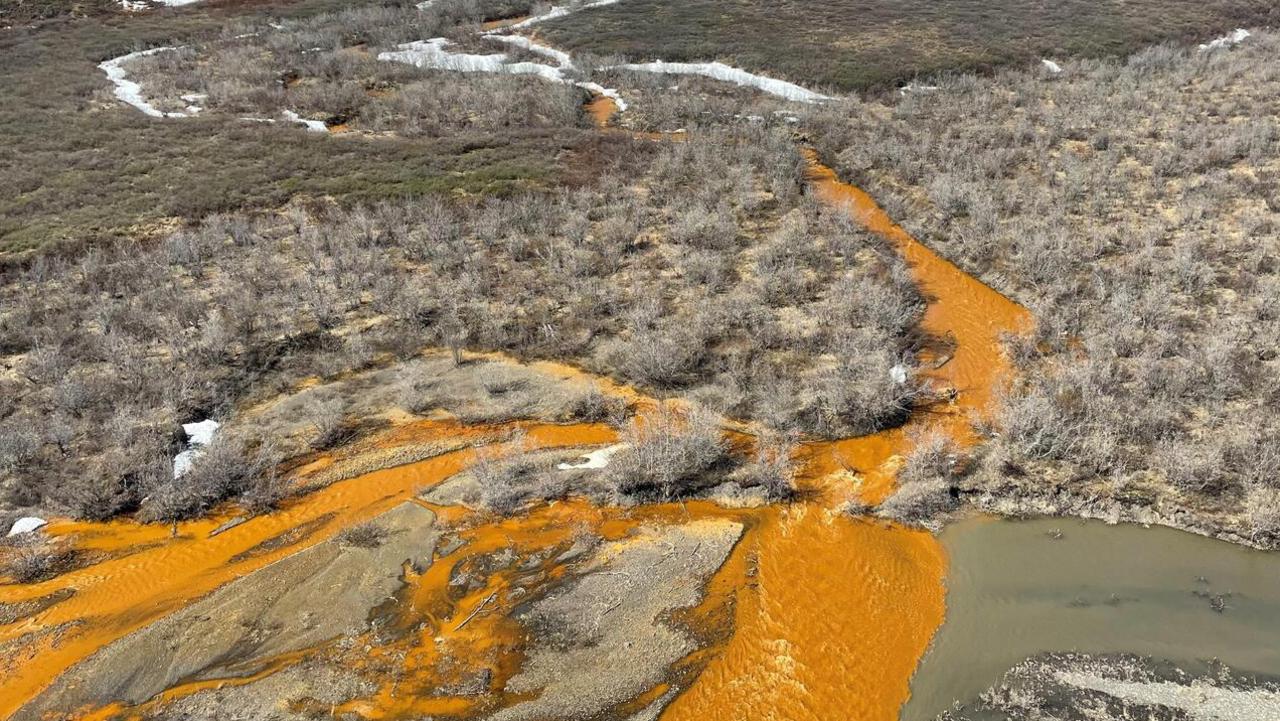‘We can see them from space’: Arctic rivers turn orange due to thawing permafrost
Some of the most pristine, crystal-blue waterways in the world have turned into ‘milky orange juice’, and a new study suggests there’s cause for concern.

Pristine, crystal-blue inland waterways have turned into ‘milky orange juice’ in a remarkable phenomenon which is worrying scientists.
Remote rivers and streams in northern Alaska’s Brooks Range are undergoing a dramatic transformation, changing from their characteristic crystal clear blue to a murky orange hue.

This alarming phenomenon, which is being attributed to minerals exposed by thawing permafrost – permanently frozen ground common in polar regions – has been documented in a new study published in Nature Communications: Earth and Environment.
A multidisciplinary team of researchers from the National Park Service (NPS), US Geological Survey (USGS), University of California, Davis (UC Davis), and other institutions have recently sampled and analysed the murky waters.
They have identified 75 locations affected by this discolouration across a vast, Texas-sized region in northern Alaska.
The findings indicate that these degraded waters could have significant implications for drinking water and fisheries in Arctic watersheds as the climate continues to change.
“The more we flew around, we started noticing more and more orange rivers and streams,” stated lead author Jon O’Donnell, an ecologist with the NPS’ Arctic Inventory and Monitoring Network.
“There are certain sites that look almost like a milky orange juice. Those orange streams can be problematic both in terms of being toxic but might also prevent migration of fish to spawning areas.”
O’Donnell first noticed the issue in 2018 when he observed a river that appeared rusty, which had been clear the previous year.

This prompted him to start compiling locations and gathering water samples in the remote region, where helicopters are often the only means of access.
Brett Poulin, an assistant professor of environmental toxicology at UC Davis and a principal investigator in the research, emphasised the extent of the problem.
“The stained rivers are so big we can see them from space,” he said.
Poulin noted that the discolouration resembles what is typically seen with acid mine drainage despite the absence of mines in the area.
One hypothesis is that thawing permafrost is exposing metal ores to water and oxygen, resulting in acid and metal release.
“Chemistry tells us minerals are weathering,” Poulin explained. “Understanding what’s in the water is a fingerprint as to what occurred.”
The impacted rivers and streams span federal lands managed by the Bureau of Land Management (BLM), Fish and Wildlife Service, and NPS, including Gates of the Arctic and Kobuk Valley National Parks.
Researchers, including Poulin and PhD candidate Taylor Evinger, have collected and analysed samples, revealing that some waters have a pH as low as 2.3, compared to the average pH of 8.

This acidic condition results from the weathering of sulphide minerals, releasing high levels of metals such as iron, zinc, nickel, copper, and cadmium.
“We see a lot of different types of metals in these waters,” Evinger noted. “One of the most dominant metals is iron. That’s what is causing the colour change.”
While O’Donnell’s initial observation was in 2018, satellite imagery has identified stained waters dating back to 2008.
“The issue is slowly propagating from small headwaters into bigger rivers over time,” he said.
“When emergent issues or threats come about, we need to be able to understand them.”
The team is now in the second year of a three-year grant to understand the changes in water chemistry, model at-risk areas, and assess implications for drinking water and fish stocks.
The problem is growing, affecting habitat, water quality, and other ecological systems, potentially turning healthy areas into degraded habitats with fewer fish and invertebrates, the researchers believe.
“There’s a lot of implications,” O’Donnell said.
“As the climate continues to warm, we would expect permafrost to continue to thaw and so wherever there are these types of minerals, there’s potential for streams to be turning orange and becoming degraded in terms of water quality.”

The NPS has expressed concern about the broader impacts of this phenomenon.
“Large amounts of organic carbon, nutrients, mercury, and other metals are stored in Arctic permafrost — perennially frozen ground,” the NPS stated.
“But as the Arctic warms, permafrost is thawing, and these compounds are being released into waterways. Metals are particularly concerning because they can be toxic to aquatic life and to people.”
In recent years, there have been abrupt increases in air and ground temperatures, exceeding the freezing threshold for near-surface permafrost.
Arctic rivers are crucial for subsistence, sport, and commercial fisheries, the NPS said, emphasising the impact of climate change already impacting high-latitude fish species, including Pacific salmon.
“The emergence of orange streams in northern Alaska represents an unexpected threat to subsistence fisheries and rural drinking water supplies,” the NPS noted.

“Communities in northwest Alaska are isolated and depend socio-economically and culturally on subsistence foods such as fish, large ungulates, and marine mammals.
“Our preliminary data suggest that metal mobilisation may increase the vulnerability of important subsistence fish species — such as Dolly Varden, chum salmon, and whitefish — to population decline.
“The metals transported downstream from headwater streams to higher-order rivers may also impact drinking water supplies to rural communities.”
Understanding the extent and persistence of stream degradation will be critical for informing management responses by federal and state agencies and adaptation strategies for rural communities and subsistence users, the researchers argued.
“I think there will be a lot more detailed work to follow up to address some of the uncertainties that we currently have,” O’Donnell said.
The research, involving scientists from Alaska Pacific University, Colorado State University, University of Alaska Anchorage, and UC Riverside, is funded by the USGS – NPS Water Quality Partnership Program, the USGS Changing Arctic Ecosystem Initiative, and the NPS Arctic Inventory and Monitoring Program.
Originally published as ‘We can see them from space’: Arctic rivers turn orange due to thawing permafrost





